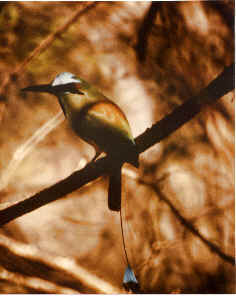 Yucatan
Birds
Yucatan
Birds
of Mexico
including those on the offshore Cozumel Island,
and in the eastern Campeche state
at the base of the peninsula
Those found during Focus On Nature Tours
in the Yucatan noted with an (*)
mar: has been found during our tours in March
jun: has been found during our tours in June
nov: has been found during our tours in November
The following list compiled by Armas Hill
Photo at upper right: the TURQUOISE-BROWED MOTMOT,
also called TOH in Mayan
and MOMOTO CEJITURQUESA in Spanish.
(Photo by Alan Brady)
Codes:
a globally threatened or rare species,
designated by Birdlife International.
(t1): critical
(t2): endangered (t3): vulnerable
(nt): a near-threatened species
globally.
The birds in the list below are coded as to their status IN MEXICO:
(MX1): endangered
(MX2): threatened
(MX3): of special concern (or near-threatened)
cz: occurs on the offshore Cozumel Island
(MXe): a species endemic to Mexico
(MXi): an introduced species in Mexico
A fine book, "Jungle of the
Maya" has recently been published (in 2006) by the University of Texas
Press. In it, there some very good photographs of wildlife in Belize, and in
nearby Guatemala & Mexico. In the following lists, pages in that book with
photos of particular species are referred to with a (p. xx)
Links:
Upcoming
FONT Birding & Nature Tours in Mexico & Central America
A List & Photo Gallery
of Mexican Birds, in 3 parts:
Part
#1: Tinamous to Shorebirds Part
#2: Jaegers to Woodpeckers
Part #3: Manakins to
Buntings
Mexican Mammals (with some photos)
Butterflies
of Mexico (with some photos)
Amphibians & Reptiles of Mexico
(with some photos)
Marine
Life, including that of the Coral Reef, of the Yucatan & Belize (with
some photos)
Directory
of Photos in this Website

Bird-List:
- Great Tinamou (MX3) (*) ______
jun,nov
Tinamus major
- Little Tinamou (MX3) ______
Crypturellus soui
- Slaty-breasted Tinamou (MX3)
(*) ______ mar,jun,nov (another name has been "Boucard's Tinamou")
Crypturellus boucardi
- Thicket Tinamou (*) ______
mar,jun,nov
Crypturellus cinnamomeus
- Plain Chachalaca (*) ______ mar,jun,nov
Ortalis vetula
- Crested Guan (MX2) (p. 47) (*) ______ nov
Penelope purpurascens
- Great Curassow (nt) (MX2) (p. 47) (*) ______
jun,nov cz
Crax rubra
Crax r. griscomi (subspecies endemic to Cozumel Is.; the only
subspecies other than the nominate in Central America from Mexico to Panama)
- Spotted Wood Quail (MX3) ______
Odontophorus guttatus (monotypic)
- Singing Quail (MX3) ______
Dactylortyx thoracicus dolichonyx
(the single member of its genus)
- Yucatan Bobwhite (*) ______ mar,jun,nov (another
name is Black-throated Bobwhite)
Colinus nigrogularis
- Ocellated Turkey (nt) (MX2) (p. 12 &
117) (*) ______ mar,jun,nov
Meleagris ocellata (monotypic)
- Fulvous Whistling Duck _____
Dendrocygna bicolor
- Black-bellied Whistling Duck (*)
______ mar,jun,nov cz
Dendrocygna autumnalis
- Greater White-fronted Goose ______ (rare or accidental in the Yucatan)
Anser albifrons
- Snow Goose ______ (rare or accidental
in the Yucatan)
Chen
(formerly Anser) caerulescens
- Brant Goose (MX2) _____
Branta bernicla
- Muscovy Duck (MX1) ______
Cairina moschata (monotypic, and
the single member of its genus)
- Wood Duck _____
Aix sponsa
- Green-winged Teal _____
Anas carolinensis
- Gadwall ______
Anas strepera
- Mallard ______ (rare or accidental in
the Yucatan)
Anas platyrhynchos
- Northern Pintail _____ cz
Anas acuta
- Blue-winged Teal (*) ______ mar,nov
cz
Anas discors
(monotypic)
- Northern Shoveler (*) _____ nov
cz
Anas clypeata
- American Wigeon______
Anas americana
(monotypic)
- Canvasback ______ (rare or accidental
in the Yucatan)
Aythya valisineria
- Redhead ______ (rare or accidental in
the Yucatan)
Aythya americana
- Ring-necked Duck ______ cz
Aythya collaris
- Greater Scaup ______ (rare or
accidental in the Yucatan)
Aythya marila
- Lesser Scaup ______ cz
Aythya affinis
- Bufflehead ______ (rare or accidental
in the Yucatan)
Bucephala albeola
- Hooded Merganser ______ (rare or
accidental in the Yucatan)
Lodhodytes cucullatus
- Red-breasted Merganser _____ cz
Mergus serrator
- Common Merganser ______ (rare or
accidental in the Yucatan)
Mergus merganser
- Masked Duck (MX2) ______ cz
Nomonyx dominicus
- Ruddy Duck ______ (rare or accidental
in the Yucatan)
Oxyura jamaicensis
- Least Grebe (MX3) (*) ______ mar,jun,nov
cz
Tachybaptus dominicus
- Pied-billed Grebe (*) ______ mar,nov
cz
Podilymbus podiceps
- Black-necked Grebe ______ (another
name has been Eared Grebe)
Podiceps nigricollis
- Cory's Shearwater ______
Calonectris diomedea
- Great (or
Greater)
Shearwater ______
Puffinus gravis
- Audubon's Shearwater ______ cz
Puffinus lherminieri
- American Flamingo (MX2) (*) ______
mar,jun,nov cz
(has also been called Caribbean Flamingo; was at one time considered
conspecific with the Greater Flamingo
of the Old World)
Phoenicopterus ruber (monotypic)
Along the northern & western coasts of the Mexico's Yucatan
Peninsula,
there are thousands of American Flamingos.
They nest in the late spring and summer in and near the Rio
Lagartos Special
Biosphere Reserve. Many of them spend the winter a couple hundred kilometers
to the west, as the flamingo would fly, at the Rio Celestun Special
Biosphere Reserve.
The Mexican population of the American Flamingo is considered fairly
healthy, having risen from a low of between 8,000 and 12,000 individuals in
the 1970s (when the Rio Lagartos
&
Rio Celestun Reserves were created),
to about 26,000 birds in the mid-1980s. Hurricane Gibert, in 1988, was a
setback to this population growth, but the flamingos have since
recovered.
- Jabiru (MX1) (*) ______ nov
Jabiru mycteria
- Wood Stork (MX3) (*) ______ jun,nov
Mycteria americana (monotypic)
- American White Ibis (*) ______ mar,jun,nov cz
Eudocimus albus
(monotypic)
- Glossy Ibis (*) _____ mar,jun cz
Plegadis falcinellus
- White-faced Ibis ______ (rare or
accidental in the Yucatan)
Plegadis chihi
- Roseate Spoonbill (*) ______
mar,jun,nov cz
Platalea (formerly Ajaia) ajaja


 Yucatan
Birds
Yucatan
Birds![]()